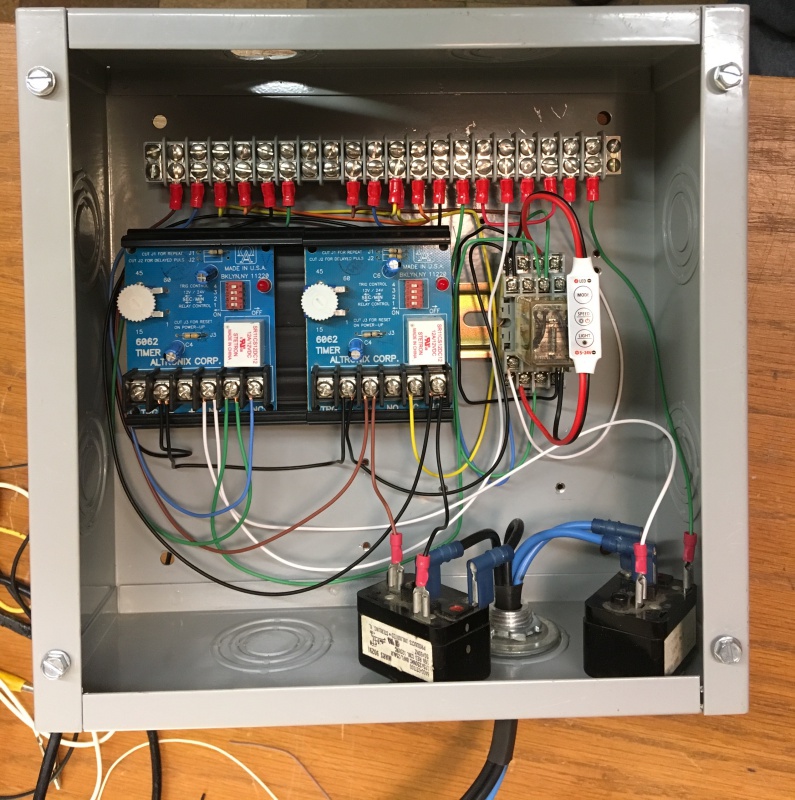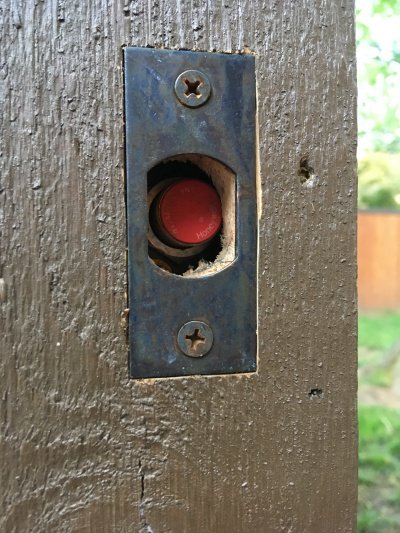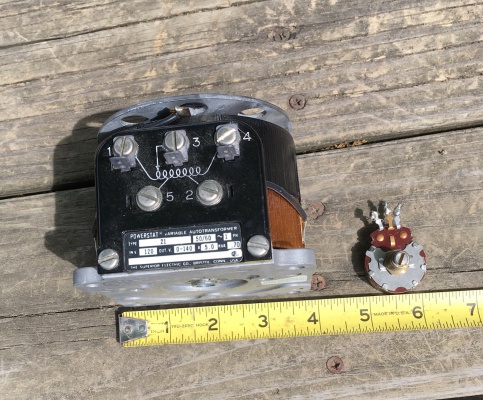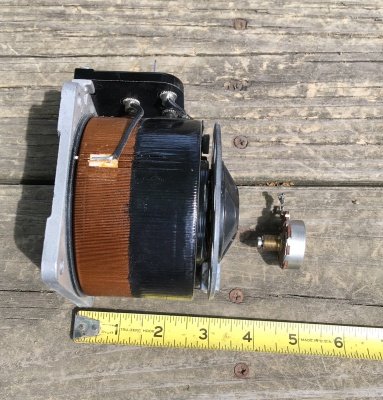Arduino Remote Home #11
As I was wiring the panel for the left garage door monitoring system  I started thinking about, what and if, I would change about my home automation system. The short answer is, when it’s completed, I wouldn’t change a thing. But that’s not to say there aren’t things that could be done differently. Here are a few of those things. Some you may find interesting and wish to work into your home automation project.
I started thinking about, what and if, I would change about my home automation system. The short answer is, when it’s completed, I wouldn’t change a thing. But that’s not to say there aren’t things that could be done differently. Here are a few of those things. Some you may find interesting and wish to work into your home automation project.
Each of these needs a little explaining.
Ceiling fans: In my system I monitor the 120 Vac going to the fans. In my case I have two wall switches, one for the light and one for the fan. They are monitored independently. As you may know most fans have a 3 speed + “off” pull chain switch. Regardless of that switch state, how the fan appears on the web page, is not based on that switch, but whether if there is voltage available at the fan. I can think of a couple of ways to monitor the fan differently. You could hack into the fan, and monitor the pull chain switch. But what if you wanted to use an in wall fan speed switch? Another option, you could use a Hall Effect sensor or Tachometer. These would give positive confirmation of whether or not the fan was spinning. But what if you had a window open and the fan began to spin, you would get false information. A current sensor seams to be the best choice. In addition to monitoring “on/“off”, you could use it for its intended purpose, monitoring current/power. However, in my design, I was most interested in low cost, both financial and programmatically, and making the system as seamless and unobtrusive as possible. The web page design also didn’t accommodate for anything other than “off and “on”. So to me “On” means using electricity, varying degrees of “on”are inconsequential which mean a higher bill. Spoken like the parent of forgetful children. I consider installing occupancy sensors that would disable the fan, but I can think of a few reasons why that isn’t practical, and would then need some kind of bypass and other hardware to make it function properly. To make matters worse, the fan in the master bedroom has an IR remote to change speed and can dim the light kit as well. So by keeping it simple, my criteria are met.
Sensors: You may think its odd that in a home automation system there are no sensors. Well not in the electronic component sense. I’m not opposed to these nifty little devices. I only had need for a photocell to monitor outside light level, and two proximity sensors to monitor the dead bolts on the front and rear gates. 
When I get around to Phase III, the solar water heating system, I will need some type of temperature and pressure sensors. As far as doing things differently with sensors, I considered occupancy sensors. In this case I would use these as Artificial Intelligence to “learn” the patterns of the home. Then use that information to “play back” the pattern in a predictive sense, or when I was not home. But if that is a serious consideration you can do that with the system I have. I also thought about adding temperature and humidity sensors on each floor, but I really don’t have a specific need for that information. I do believe that some people could benefit from a system that not only senses but controls temp. & hum. those that have respiratory issues. Again those things can be accomplished without specialty sensors.
Task Lighting: More specifically the under cabinet LED lights. At the time I remodeled the kitchen I installed adhesive backed white LED strips and two of the manufacturers “dimmers”, one for each side of the kitchen. Little did I know at that time, that the dimmers are actually PWM modules. In my “on, off” only system there is no way to change the light level. So when I view the status of the “Kitchen Under Cab Lts” I’m only given the fact that voltage is or is not present at the transformer, not the output of the PWM module. I can see that some may wish to add remote access to PWM dimming to achieve monitoring and control of it. Long before I decided to build the system, I had installed auto-transformer type dimmers in the dinning room. For those un-familiar with these, they look like gigantic potentiometers.
The difference is that instead of changing the resistance, they change the winding length of a transformer, thus changing the output voltage.
When dimming incandescent light bulbs with an inexpensive, electronic type dimmer, you may notice a high pitch squeal emanating from the bulbs. (That noise really bothers me.) You don’t have that with auto-transformers. The downside of these is that, as far as I know, they do not come in a “3-way” configuration. So I installed them in series with the light fixtures and switches, just like with the kitchen LEDs. I do know that there are 24 Vac motors that mount directly to the auto-trans. that have duel windings and very low rpm to remotely turn the shaft. That motor could be controlled from as many locations as necessary. Small issue is that you need two sets of switches for each dimmer, one for clockwise and one for counter clockwise rotation. If you opted to use that set up, which I think would be totally awesome, you would still need some type of positive feedback for monitoring.
Final Thoughts: When I started this project Arduino was relatively new and none of the “Off the Shelf” gadgets existed. I’m not bitter at those facts, quite the opposite. For instance if the Hue lightening system was available back then, I probably would have never done this project. That means I wouldn’t have learned a thing. I’m not saying I think Hue makes you lazy. I am saying if you have the desire to build a home automation system, do it from scratch, you’ll learn so much. And those of you blessed with the ability to easily write code, the hardware part is, in my opinion, not as time consuming to learn.
If you’ve just found this blog and find it even the slightest bit interesting, I encourage you to go back and check them out in order. I’ve tried to explain the system with as much detail as possible so as not to bore.
Congratulations @electricswine! You have completed some achievement on Steemit and have been rewarded with new badge(s) :
Click on any badge to view your own Board of Honor on SteemitBoard.
To support your work, I also upvoted your post!
For more information about SteemitBoard, click here
If you no longer want to receive notifications, reply to this comment with the word
STOPJoin our Discord Channel to connect with us and nominate your own or somebody else's posts in our review channel.
Help us to reward you for making it ! Join our voting trail or delegate steem power to the community account.
Your post is also presented on the community website www.steemmakers.com where you can find other selected content.
If you like our work, please consider upvoting this comment to support the growth of our community. Thank you.
You have a minor misspelling in the following sentence:
It should be sense instead of sence.thanks.
Hello, electricswine, I'm @ArtTurtle, an upvote bot run by @Artopium. I just upvoted this post and resteemed it because I'm following you and, well, that's just what I do. Reciprocation is always appreciated! If you no longer wish to have @ArtTurtle follow you please reply to this comment with 'STOP'.
Congratulations @electricswine! You have completed some achievement on Steemit and have been rewarded with new badge(s) :
Click on any badge to view your Board of Honor.
For more information about SteemitBoard, click here
If you no longer want to receive notifications, reply to this comment with the word
STOPDo not miss the last announcement from @steemitboard!
@therealwolf 's created platform smartsteem scammed my post this morning (mothersday) that was supposed to be for an Abused Childrens Charity. Dude literally stole from abused children that don't have mothers ... on mothersday.
https://steemit.com/steemit/@prometheusrisen/beware-of-smartsteem-scam